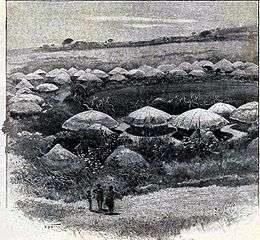Kraal

_-_Copy.jpg)
Kraal (also spelled craal or kraul) is an Afrikaans and Dutch word (also used in South African English) for an enclosure for cattle or other livestock, located within an African settlement or village surrounded by a fence of thorn-bush branches, a palisade, mud wall, or other fencing, roughly circular in form. It is similar to a boma in eastern or central Africa.
In Curaçao, another Dutch colony, the enclosure was called "koraal" which in Papiamentu is translated "kura" (still in use today for any enclosed terrain, like a garden).
Etymology
In the Dutch language a kraal is a term derived from the Portuguese word curral,[2] cognate with the Spanish-language corral, which entered into English separately.[3][4] In Eastern and Central Africa, the equivalent word for a livestock enclosure is boma, but this has taken on wider meanings.
In some Southern African regions, the term Kraal is used in scouting to refer to the team of Scout Leaders of a group.
Homestead
The term primarily refers to the type of dispersed homestead characteristic of the Nguni-speaking peoples of southern Africa. Although from the period of colonisation, European South Africans and historians commonly referred to the entire settlement as a kraal[nb 1], ethnographers have long recognised that its proper referent is the animal pen area within a homestead. Modern ethnographers call the several human dwellings within a homestead (Xhosa: umzi, Zulu: umuzi, Swazi: umuti) houses (singular indlu; plural Xhosa and Zulu izindlu, Swati tindlu).
Folds for animals and enclosures made specially for defensive purposes are also called kraals.
Notes
- ↑ in 1894 Theal notes that the word kraal ...is also used to signify a collection of either Hottentot or Bantu Huts..., in 1910 Kidd describes a kraal as The natives lives in round huts, which are build of wattle and daub. A kraal consists of a number of these huts grouped in a circle or crescent; the cattle-kraal, which is usually a large circular enclosure made of thorn-bush branches, being places in the centre of the circle, or else on the cord of the crescent or horseshoe. In 1913 Pettman notes that kraal may refer to Any native village or collection of huts[4][5][6]
See also
References
- ↑ "Building an African Kraal". The Wesleyan Juvenile Offering: A Miscellany of Missionary Information for Young Persons. Wesleyan Missionary Society. X: 78. July 1853. Retrieved 29 February 2016.
- ↑ Random House Unabridged Dictionary: Kraal: "Origin: 1725–35; < Afrikaans < Portuguese curral pen"
- ↑ Weekley, Ernest (1912). The Romance of Words. London: John Murray. p. 23.
- 1 2 Theal, George McCall (1894). "Explanation of terms". South Africa (the Cape Colony, Natal, Orange Free State, South African Republic, and all other territories south of the Zambesi). London: Unwin. p. xix.
- ↑ Kidd, Dudley (1910). South Africa. London: A. and C. Black.
- ↑ Pettman, Charles (1913). Africanderisms; a glossary of South African colloquial words and phrases and of place and other names. London, New York: Longmans, Green and co. p. 280.
Further reading
| Wikimedia Commons has media related to Kraals. |
- Potgieter, D. J. (ed.) (1972) Standard Encyclopedia of Southern Africa. Cape Town: Nasionale Opvoedkundige Uitgewery ISBN 978-0-625-00322-8.
- Südafrikas Norden und Ostküste. Dormagen: Reisebuchverlag Iwanowski. 2006. p. 521. ISBN 3-933041-18-X.
- Brockhaus Enzyklopädie. 21. Auflage. Mannheim: Brockhaus F.A., 2006 ISBN 3-7653-4115-0; Volume 15.
- The New Encyclopædia Britannica. 15th ed. Chicago: Encyclopædia Britannica, Inc., 2007 ISBN 978-1-59339-292-5 (Micropædia, Volume 6).